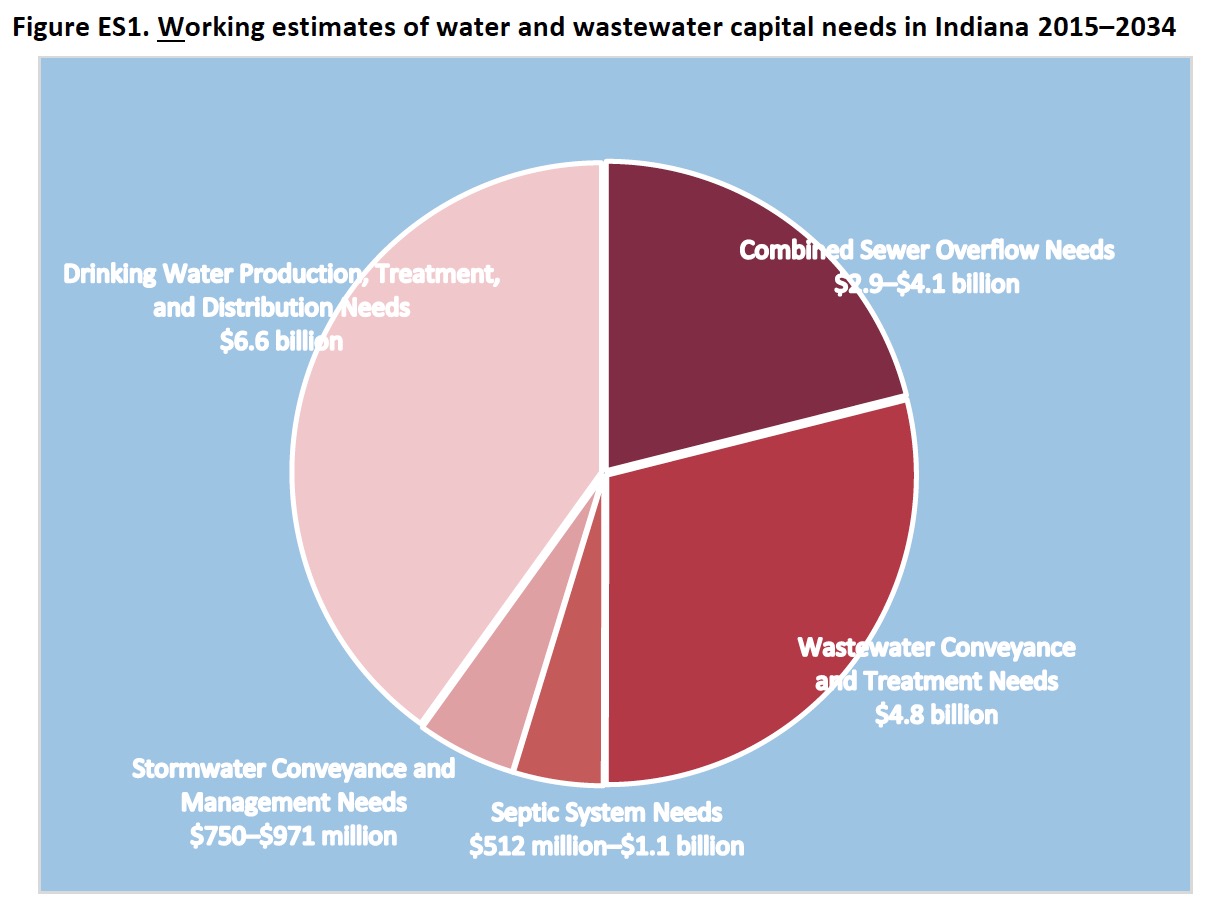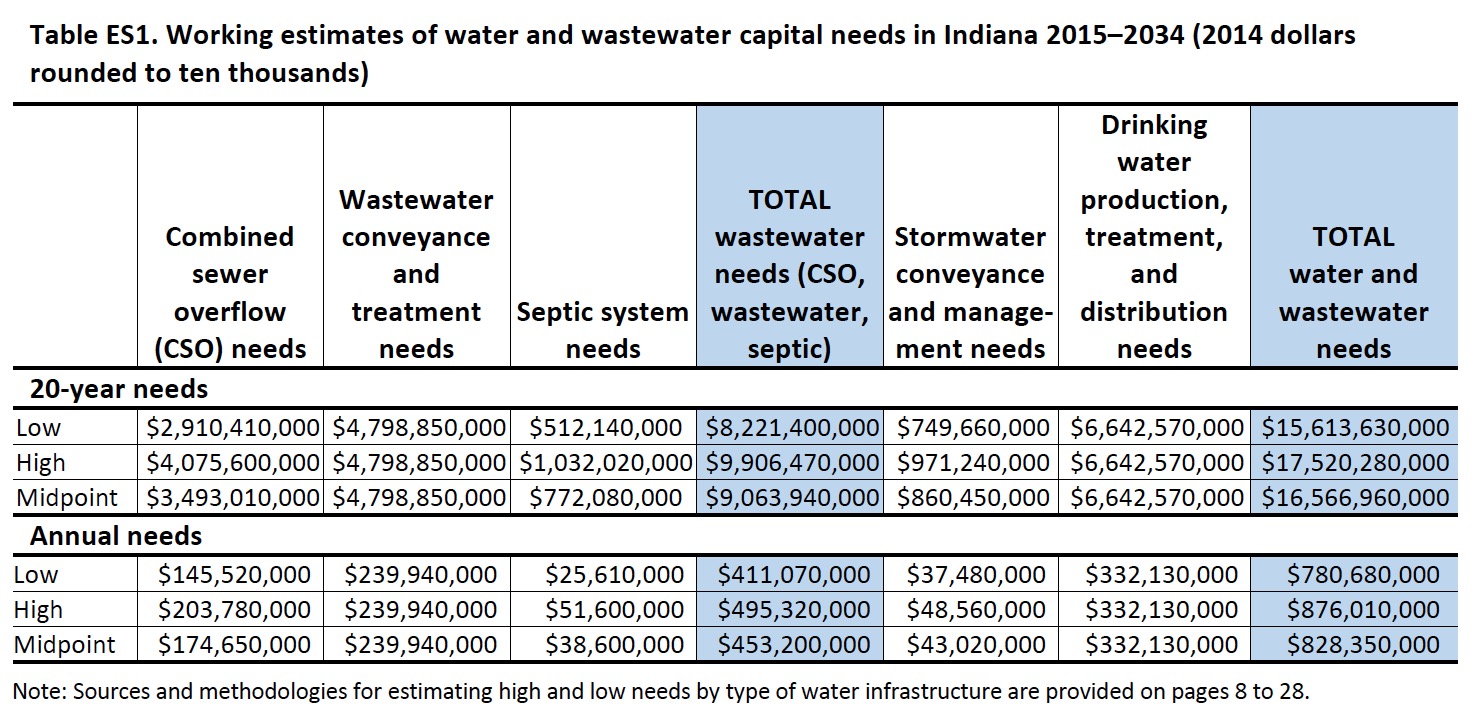INDIANA ADVISORY COMMISSION ON INTERGOVERNMENTAL RELATIONS (IACIR)
Executive Summary
Financial Needs for Water and Wastewater Infrastructure in Indiana (2015–2034) is an assessment of water and wastewater infrastructure needs in Indiana. This study is sponsored by the Indiana Advisory Commission on Intergovernmental Relations (IACIR) and the Indiana Office of Community and Rural Affairs (OCRA). The Indiana Association of Regional Councils provided research assistance. The Indiana Finance Authority State Revolving Loan Programs (SRF), U.S. Department of Agriculture Rural Development – Indiana (USDA RD), ACEC Indiana Funding Sources Committee, and the Indiana Rural Wastewater Task Force provided additional assistance and important feedback during the effort.
Needs are defined generally as the costs of investments required for capital projects to rehabilitate or improve infrastructure to meet current service or regulatory requirements. Twenty-year needs (2015–2034) are estimated here for: (1) correction of combined sewer overflows (CSO); (2) wastewater conveyance and treatment; (3) remediation of failing septic systems; (4) stormwater conveyance and management; and (5) drinking water production, treatment, and distribution. The estimates are based on self-reporting, surveys, engineering models, and other data depending on the type of infrastructure. A range of estimates is presented to account for the uncertainty associated with methodologies developed in the absence of complete site-specific data.
20-year water and wastewater capital needs are $15.6–$17.5 billion
The 20-year working estimates of statewide needs for water and wastewater infrastructure range from $15.6 to $17.5 billion (Figure ES1 and Table ES1). This likely is an underestimate of actual needs because some infrastructure types are underestimated, and the estimate does not include all types of infrastructure, operations and maintenance, the cost of potential new regulations, or potential cost overruns.
20-year water and wastewater capital needs funding gap are $6.5–$8.5 billion
Current evidence indicates water and wastewater needs will not be met by current levels of investment by state and local governments. Between January 2005 and December 2014, local governments invested approximately $3.4 billion in CSOs, wastewater, and stormwater infrastructure, or $343 million annually. These entities invested approximately $1.1 billion in drinking water infrastructure or $111 million annually (Dodge Data & Analytics, 2015). State and federal agencies, including the SRF, OCRA, and the U.S. Department of Agriculture Rural Development, supported many of these investments. If infrastructure spending is similar to the previous estimate (Dodge Data & Analytics, 2015), state and local governments will have to invest an additional $6.5 to $8.5 billion, or $326 to $423 million annually, to meet the infrastructure capital needs identified in this report.
Drinking water infrastructure accounts for the most needs: $6.6 billion
The 20-year working estimate of statewide capital needs for drinking water infrastructure is $6.6 billion. This includes estimates for three categories of systems:
- $1.9 billion for large systems (serving greater than 100,000 population)
- $3.6 billion for medium systems (serving 3,301 to 100,000 population)
- $1.2 billion for small systems (serving 3,300 or less population)
This estimate is based on needs from the U.S. Environmental Protection Agency 2011 Drinking Water Needs Survey and Assessment (2013), referred to as “2011 DWNS” hereafter. For medium and large facilities, the DWNS is based specifically on national data from all large systems and a sample of medium systems. Infrastructure needs from the 2007 national assessment were used to estimate needs for small systems. While the 2011 DWNS is the best available estimate, it may be conservative because it does not include infrastructure needs that are not eligible for the SRF loan program.
Wastewater conveyance and treatment needs are $4.8 billion
The 20-year working estimate of statewide capital needs for correction of wastewater conveyance and treatment is $4.8 billion. These needs are based on estimates from the U.S. Environmental Protection Agency 2012 Clean Watershed Needs Survey [database](2015c) referred to hereafter as “2012 CWNS.” Of the 446 municipal sewer systems surveyed, 212 responded to the 2012 CWNS (47.5 percent). To address this underreporting of needs, the research team calculated per capita costs for respondent systems in the aggregate and applied that factor to nonrespondent systems. The estimate of needs reported here is the aggregation of the reported and extrapolated needs.
Combined sewer overflow corrections needs range from $2.9–$4.1 billion
The 20-year working estimates of statewide capital needs for the correction of CSOs is $2.9 to $4.1 billion. Seventy-one communities in 48 counties had outstanding CSO infrastructure projects in March 2015, which is fewer communities with documented needs than in 2003 (Lindsey, Worgan & Palmer).
The range of needs documented here is based on costs documented in community long-term control plans. Costs were identified for the 2012 CWNS using documentation contained in these plans. Similarly, the 2015 estimate also was based on an analysis of projects of community long-term control plans identified as outstanding in Indiana Department of Environmental Management (IDEM) Work Activity Log (WAL) Tasks Reports on March 23, 2015. The two estimates are used to establish a range of needs in each county.
Remediation of failing septic systems needs range are $512 million–$1 billion
The 20-year working estimate of statewide capital needs for solutions to septic system failures ranges from $512 million to $1 billion. The approach to estimating needs for remediation of failing septic systems involved determining the number of failing systems in each county and multiplying that number by the estimated cost of remediation. The data were collected by surveying county health departments. While a number of counties did not respond to the survey, the responses from respondent counties were too varied to create estimates that could be used for the missing information. No adjustment has been made to the survey responses to account for nonrespondents. As a result, the needs reported here likely are an underestimation.
Stormwater management needs are $750–$971 million
The 20-year working estimate of statewide capital needs for stormwater infrastructure ranges from $750 to $971 million. Currently, there is no comprehensive compilation of stormwater infrastructure needs. A very limited set of needs for storm sewers are included in the 2012 CWNS. Many of these needs are drawn from plans prepared by communities required to have National Pollutant Discharge Elimination System (NPDES) Municipal Separate Storm Sewer Systems (MS4) programs to control pollutants in urban runoff. The coverage of these needs is inadequate for use to estimate overall stormwater infrastructure needs. The alternate approach for estimation is based on the following factors: the number of developed acres in each county, the per-acre stormwater programming cost for varied levels of services, assumptions about the proportion of stormwater costs associated with capital needs, and assumptions about the level of service that is required to meeting water quality and drainage/flooding objectives. The alternate method of estimation was used except in a few cases when needs identified in the 2012 CWNS were greater.
All counties have significant needs
All 92 Indiana counties have significant water and wastewater infrastructure needs (Table ES2). Across counties, the working estimates of needs range from lows of $11.5 to $12.2 million in Warren County and $13.5 to $13.7 million in Union County to highs of $3.2 to $3.5 billion in Marion County and $1.2 to $1.3 billion in Lake County. Of the low estimates, including Marion and Lake counties, 31 counties have needs greater than $100 million. Thirty-seven additional counties have low estimated needs greater than $50 million. Of the high estimates, 34 counties have needs greater than $100,000. Thirty-six additional counties have high estimated needs greater than $50 million.
Download full version (PDF): Financial Needs for Water and Wastewater Infrastructure in Indiana
About the Indiana Advisory Commission on Intergovernmental Relations (IACIR)
www.iacir.spea.iupui.edu
The Indiana Advisory Commission on Intergovernmental Relations (IACIR) was established by the General Assembly in 1995 to provide a forum to plan for and address the problems that will arise as greater demands are made on state and local governments. Based upon federal and other states’ enabling statutes, Indiana is one of 20 states to establish an intergovernmental commission.
Tags: IACIR, IN, Indiana, Indiana Advisory Commission on Intergovernmental Relations, Indiana Office of Community and Rural Affairs, OCRA, Water Infrastructure








 RSS Feed
RSS Feed